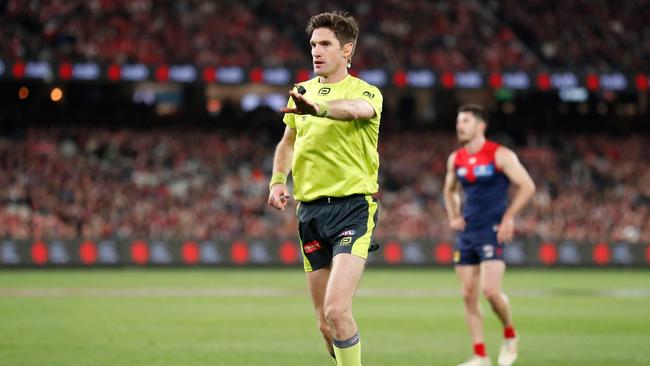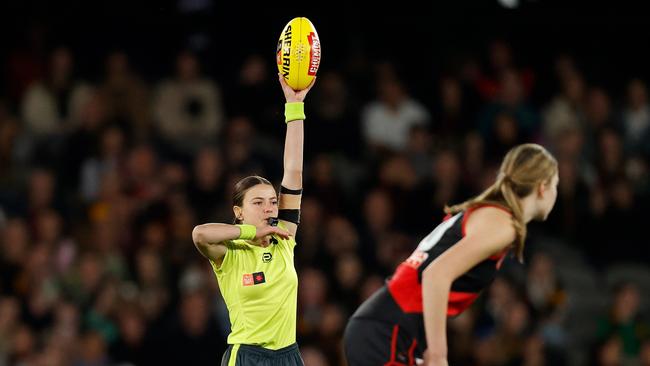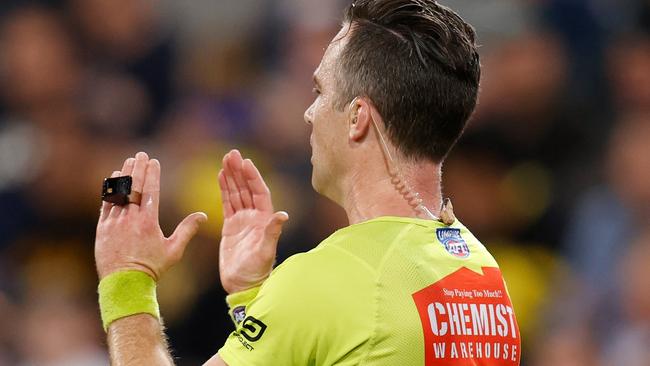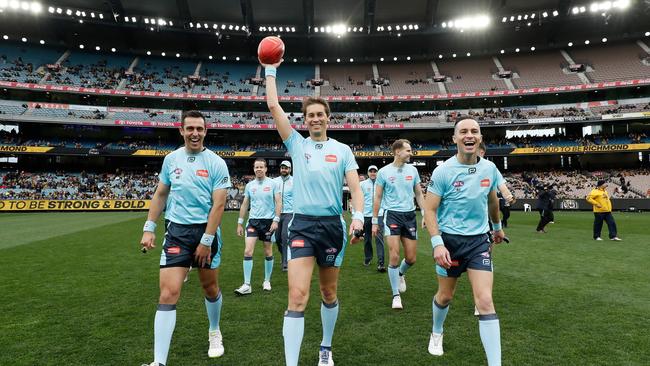AFL 2022: AFLW will lose access to AFL umpires for finals amid shortage
An umpire shortage has forced the AFLW to call on AFL umpires for this season — but a contract quirk means they will lose them when it matters most.
AFL News
Don't miss out on the headlines from AFL News. Followed categories will be added to My News.
The AFLW will lose access to AFL umpires for the finals despite using the sport’s best decision-makers during the home-and-away season.
The Herald Sun can reveal a national shortage of umpires forced the AFLW to enlist AFL umpires, which will leave the league with an umpiring bill of several hundred thousand dollars for the season.
But AFL umpires are only contracted until October 31 and the AFLW home-and-away season is set to finish on October 30.
The league on Monday confirmed AFL umpires would not officiate women’s finals.
The AFL will call upon the best state-league umpires to fill the void.
Watch every match prior to the AFL grand final Live & Ad-Break Free In-Play on Kayo. New to Kayo? Start your free trial now >

“To assist with the change of season timing and the development of our umpiring pathways, AFL listed umpires not selected for AFL Finals have put their hands up to umpire AFLW matches in Season Seven,” a spokesperson said.
“Through the opening rounds we have been pairing them with younger AFLW umpires to support their ongoing development.
“We have some great talent coming through the umpiring ranks and applaud the AFL listed umpires for providing leadership and guidance to our new generation of umpires.“
It’s understood AFL umpires bank $2343 per women’s match, which is almost six times more than AFLW umpires who they share the field with. They take home about $412.
The AFL contingent will be sent on holidays after September, once the full AFLW umpiring list is available following state-league finals.That will ensure the AFL umps get their mandatory break before pre-season for 2023.
Seventeen AFL-listed umpires have officiated an AFLW match this season. At least one has been involved in every game with the weekly fees costing roughly $40,000.
The league is thrilled at the blend of experience and development currently on display, with 16-year-old Emma Stark umpiring with AFL pair Nick Brown and Eleni Glouftsis on Saturday.

Umpiring sources claim the low numbers of AFLW umpires are due to the AFL’s chronic lack of investment in recruiting and lack of support of female umpires.
In May the Herald Sun exclusively published the AFL’s secret report on the national shortage of female umpires: “Girls and women in Australian football umpiring: Understanding registration, participation and retention”.
That 62-page document exposed a toxic culture of sexual harassment and bullying that has long driven female umpires out of football.
But the AFL largely ignored its own research, with AFL chief executive Gillon McLachlan admitting he had not read the report until it was published by the Herald Sun.
Debunking the arc myths: Did Lynch’s reaction impact call?
— Jon Ralph
The AFL will be in a position to trial ball-tracking technology that would have definitely ruled on Tom Lynch’s finals set shot as early as next year.
Debate raged on Friday about whether Lynch’s shot was a goal or behind as video shot from a fan in the stands appeared to show the ball definitely travelled over the goalpost.
The smart ball technology which involves small microchips in a ball weighing only a few grams is already in operation in Australia’s Super Rugby competition after successful trials.
The smart ball technology operated by sports tech firm Sportable involves eight beacons across a stadium, with the microchips in the ball’s bladder communicating with those sensors 20 times a second.
As well as providing complex data for broadcasters and fans on ball speed, distance and hang time, it establishes a definitive path for the ball in goal line decisions.
It is understood the AFL met with Sportable last week and is open to a trial of that technology to assess how it would work in goal line decisions.
On Thursday night the AFL ruled the Lynch decision was correct, stating: “The ARC reviewed all the camera angles and it is viewed as a definitive behind. The correct call was made.”
It is understood the player reaction to goals plays no part in the ARC system given there are a trio of operators who come to a definite position.
The ARC operators might have been reassured by Lynch’s reaction but they are required to make definitive judgments based on video footage rather than human emotion.
The league is actively exploring the Sportable connection, with Eddie McGuire’s Jam TV and the Nine network already media partners.
The best angle yet. If only we had something like that on the night https://t.co/jpNfZxIIpF
— Jon Ralph (@RalphyHeraldSun) September 2, 2022

McGuire has hinted at a possible breakthrough in recent months regarding a more expansive and comprehensive goal line review system that would allow definitive decisions for goals kicked over the goalpost.
Brisbane AFL legend Leigh Matthews said on Friday it was “disturbing” a decision was made to overturn the goal on a 50-50 decision.
“I kind of would like it more definitive, particularly when you have got a situation where the assessment was, if the post went up 50m, the ball would have actually hit the post rather than going over the top of the post, that’s what the score review officer, the bunker man as we call him, came up with,” Matthews told 3AW.
“It’s a bit disturbing to be honest because you want it to be definitive. I don’t know what the balance of probabilities are. Does it need to be 99 per cent or 90 per cent or 60 per cent? That’s what the debate is all about.”
To July this year there were 127 score reviews with only one proved incorrect.
In 32 of those occasions the goal umpire’s decision was overturned.
Under those ARC decisions the controlling field umpire gathers evidence for a “provisional call”, which in this case was a goal.

The score reviewer has 45 seconds to make a call, with each game having three officials on call. They are a controller who operates the camera angles and Hawk-Eye technology, an analyst and a supervisor.
The analyst gives their opinion over a headset and the supervisor can confirm the decision or challenge it.
If the analyst and supervisor disagree they revert to the umpires call, but in this case they both believed the Lynch kick was a behind which travelled over the goalpost.
The ARC receives only camera angles that are available to the broadcaster and the broadcasters use only the vision from the ARC so there is no confusion.




